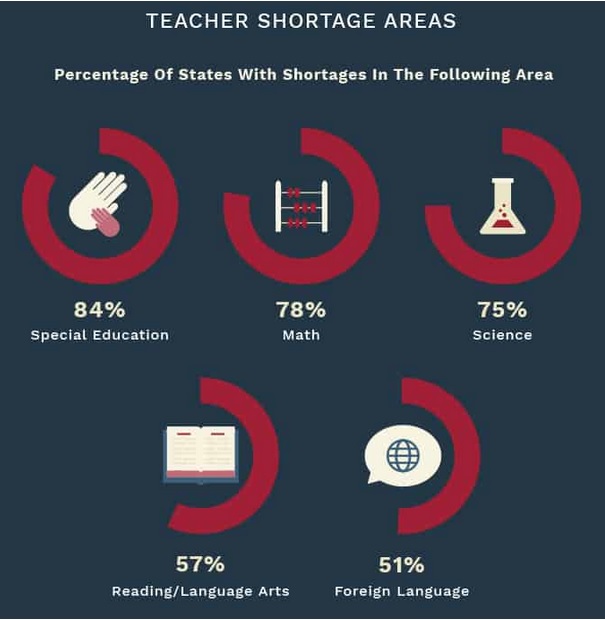6 Practical Approaches To Address The SPED Teacher Shortage Crisis
5th April 2024

Every school year starts with a lot of surprises. You sometimes get your class rosters rather late in the game, and you never know which children will have IEPs in your class. Your SPED instructor is one of the other teachers you work with often.
However, as a result of the nationwide teacher shortage, an increasing number of instructors are feeling the impacts of the shortfall. Let’s dive right into why there is a teacher shortage and what you can do about it.
Why Is There A Special Education Teacher Shortage?

Source: www.teachersoftomorrow.org
Here are three main reasons that contribute to the SPED teacher shortage:
- Most special education teachers feel burned out and stressed
- Most SPED teachers look for different career paths due to low pay
- There are very few people who are entering the workforce to work as teachers
- SPED teachers are often required to fulfill extensive responsibilities with limited resources
Hey, do you follow us on Social Media? We regularly share upgraded educational content, tips, feedback and more. Check us out by clicking the profiles here - Facebook / Twitter / LinkedIn / Pinterest / Instagram / YouTube
6 Ways To Solve The Problem Of SPED Teacher Shortage
There is no easy way to fix this crisis, however, here are 6 approaches that can help you address the root cause and improve the retention of your teachers:
1. Incorporate Technology And Live Learning
In the post-pandemic educational environment, technology is becoming more and more important in providing and enabling education, especially special education. One fascinating example is synchronous learning in real-time. Administrators who support special education instructors can benefit from synchronous remote instruction in several ways:
- Adding live synchronous learning to grade-level content helps meet IEP requirements
- It acts as core instruction for students who might require extra support or a slower instruction pace
- It also serves as a way to alleviate teacher workloads
This strategy provides children who require extraordinary attention a road to the education they deserve and enables districts to provide them with high-quality, focused instruction.
2. Alleviate Teacher Workloads
One of the main causes of burnout in special education is unmanageable workloads. Whatever the amount of time allocated to address these needs like IEPs, differentiated teaching, accommodations, adjustments, and reporting, it never seems to be enough. There are actions any district may take to reduce these caseloads, especially in the face of a teacher shortage.
Some districts relieve in-class instructors by using LIVE synchronous solutions, allowing them to concentrate on supporting inclusion, personalized intervention, progress tracking, and IEPs. The in-classroom instructor can focus on other tasks while a Special Ed LIVE remote teacher conducts part of the group teaching.
3. Improve In-Classroom Support
Offering adequate in-classroom support to both students and special education teachers is vital. This alleviates some of the pressure from the teachers and enhances the student's ability to learn. Providing extensive support to the teachers in the form of flexibility can allow them to offer direct instruction to students.
The paraprofessionals then can provide better support to the students who might need more personalized instruction. The instructors can handle lesson planning while SPED teachers can attend IEP meetings as guests to speak to parents about their classroom participation and progress.
4. Enhance Teacher’s Work Environment
A stable and peaceful work environment can significantly impact SPED teacher's burnout and attrition rates. If teachers are allowed to work remotely and establish their working hours, they can contribute to better work-life balance and attain higher job satisfaction.
When teachers are allowed to work in the schedule that works best for them, they tend to be more productive. This also allows teachers to have more opportunities to continue doing what they love to do and in environments they are most comfortable in.
5. Remove Geographic Constraints While Hiring
Another factor that contributes to the problem of teacher shortage is geographic constraints. Many low-income and rural districts struggle to compete with districts in prime locations while attracting highly qualified and certified teachers.
However, if teachers are allowed to apply from anywhere and teach in a remote setting and meet the institution's certification requirements, it eliminates the location problem. Removing these geographical barriers can connect certified special education teachers with the organizations that need them the most.
6. Increase SPED Teacher Salaries
Offering highly competitive salaries is also an invaluable tool that attracts and retains qualified and experienced special education teachers. Most special education teachers earn the same as their general counterparts however, there is a significant increase in their job responsibilities.
Their day-to-day demands are always on the rise and so are the higher levels of certification and education. Thus, higher pay with attractive bonuses and benefits can improve recruitment and prevent teachers from leaving.
Revolutionize Your Approaches To Tackle Teacher Shortage
The SPED teacher shortage is an urgent and ongoing challenge however, lasting change is multi-faceted. Equipping your teachers with a Bachelor of Education in Special Educational Needs program allows them to have the bandwidth for IEPs, personalized instruction and more. Along with this, follow the tips mentioned above to reduce the load on classroom teachers and paraprofessionals thus helping them stay.
We believe education should be accessible for everyone. That’s why we don’t charge for our blogs. Find the right course that will help you in your career with us, contact us at - 1800–212–6400. You can mail us at act@asiancollegeofteachers.com.








